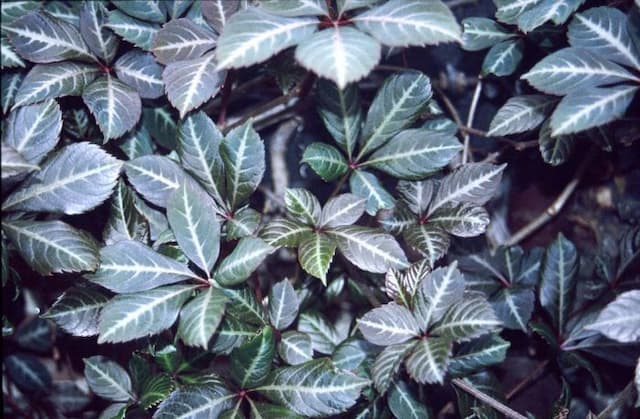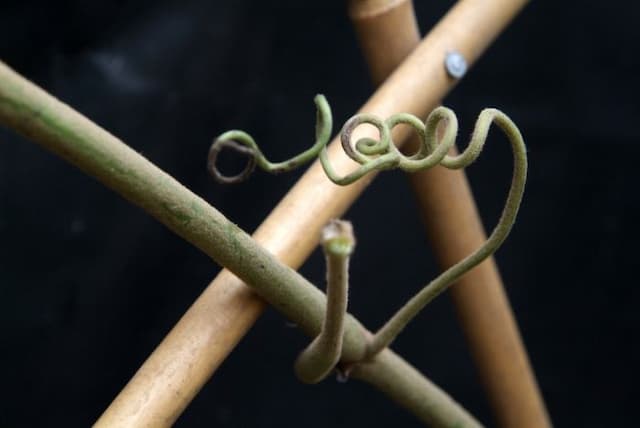Auxerrois Blanc Vitis vinifera 'Auxerrois' (O/w)

ABOUT
The 'Auxerrois' is a variety of grapevine known primarily for its role in winemaking. This plant has long, sprawling vines that possess a climbing habit, relying on other structures or trellises for support. The leaves of 'Auxerrois' are large, lobed with jagged edges, and display a rich green color which can turn to shades of gold or red in the fall, adding to the visual appeal of the vineyard. Clusters of small, greenish-yellow to golden grapes hang from the vines when in season. These grapes are typically tightly packed together in bunches and vary in sweetness. The skins of the grapes are thin and the flesh is juicy, characteristics that are desirable for producing a range of white wines. The blooms of the 'Auxerrois' grapevine are petite and inconspicuous, often a greenish-white, blending seamlessly with the foliage and only noticeable upon close inspection. Overall, the appearance of the 'Auxerrois' grapevine is largely defined by its fruit-bearing capacity and the seasonal changes in leaf color that add an ornamental quality to its practical agricultural value.
About this plant
 Names
NamesFamily
Vitaceae.
Synonyms
White Auxerrois, Auxerrois Blanc.
Common names
Vitis vinifera 'Auxerrois'
 Toxicity
ToxicityTo humans
The common name for Vitis vinifera 'Auxerrois' is grapevine. There are no inherent toxic compounds in the fruit (grapes) to humans under normal circumstances. However, the grape plant parts such as leaves, stems and roots do not contain toxic substances that would cause poisoning in humans when ingested in typical amounts. It should be noted, though, that some individuals may have allergic reactions to grapes or products made from grapes, like wine. Furthermore, excessive consumption of grapes or grape-derived products like raisins or wine can lead to digestive discomfort, including diarrhea or upset stomach due to natural fruit acids, and possible alcohol intoxication when it comes to wine.
To pets
The common name for Vitis vinifera 'Auxerrois' is grapevine. Grapes and raisins can be highly toxic to some pets, particularly dogs. The consumption of grapes, raisins, or any part of the grapevine by pets can lead to acute kidney failure. Symptoms of grape or raisin toxicity in pets may include vomiting, diarrhea, lethargy, abdominal pain, decreased appetite, and severe kidney failure which can be fatal if not treated promptly. Pet owners should avoid giving grapes or raisins to their pets and ensure that these foods are out of their reach to prevent accidental ingestion. If ingestion occurs, immediate veterinary attention is recommended.
 Characteristics
CharacteristicsLife cycle
Perennials
Foliage type
Deciduous
Color of leaves
Green
Flower color
Greenish-yellow
Height
4-6 feet (1.2-1.8 meters)
Spread
3-5 feet (0.9-1.5 meters)
Plant type
Climber
Hardiness zones
7
Native area
Europe
Benefits
 General Benefits
General Benefits- Grape Production: The Vitis vinifera 'Auxerrois' is primarily grown for its grapes, which are used in wine-making, particularly in white wine production.
- Landscape Aesthetic: This variety of grapevine can add a picturesque element to gardens, arbors, and landscapes, offering visual interest throughout the growing season.
- Economic Value: 'Auxerrois' grapes have significant economic value for the wine industry, with specialty wines often commanding higher prices.
- Pollinator Attraction: Grapevines can attract bees and other pollinators to the garden, aiding in the pollination of other plants.
- Shade Provision: When trained on pergolas, trellises, or arbors, the dense foliage of the grapevine provides natural shade and creates cool, shaded areas.
- Educational Interest: For those interested in viticulture, growing Vitis vinifera 'Auxerrois' offers hands-on experience with grape cultivation and wine grape varietals.
- Cultural Significance: Grapevines have a long history intertwined with many cultures, and growing Auxerrois can connect individuals with agricultural traditions and history.
- Wildlife Habitat: The dense foliage can provide shelter for birds and beneficial insects, integrating well with wildlife-friendly garden designs.
 Medical Properties
Medical Properties- Antioxidant properties: The grape seeds from Vitis vinifera contain proanthocyanidins which have antioxidant capabilities.
- Cardiovascular health: Resveratrol, found in the skin of grapes, may contribute to cardiovascular health by influencing cholesterol levels and protecting blood vessels.
- Anti-inflammatory effects: Components in Vitis vinifera, such as resveratrol and other polyphenols, may exhibit anti-inflammatory properties.
- Anti-carcinogenic potential: Certain compounds in grapes, including resveratrol, have been studied for their potential anti-carcinogenic effects, although more research is needed.
 Air-purifying Qualities
Air-purifying QualitiesThis plant is not specifically known for air purifying qualities.
 Other Uses
Other Uses- Vine leaves from the grape plant can be used as natural wrappers for grilling or steaming small portions of food, imparting a subtle flavor and preventing the food from drying out or burning.
- The tendrils of the grape plant can be woven into decorative wreaths or small crafts which can then be dried and used as home decor.
- Grape wood, particularly from older vines, can be repurposed into furniture or carved to make unique art pieces and ornaments.
- During pruning, grape canes can be collected and used as a natural material for basket weaving and other fibre arts.
- The grape must, which is the freshly crushed grape juice that contains the skins, seeds, and stems, can be reduced to create a syrup called saba, which is used in traditional Mediterranean dishes.
- Extracts from the leaves and vines can be used as a natural dye for fabric or yarn, producing different tones when used with various mordants.
- Thick grape vines can be dried and used as fuel in wood-fired ovens, imparting a delicate flavor to baked goods.
- Grape pomace, the solid remains after pressing the fruit for juice, can be composted and used as a rich organic fertilizer in gardens or farms.
- The robust root system of the grape plant can help control erosion on slopes, their roots holding the soil firmly in place.
- Live grape vines can be trained to create living fences or green walls, contributing to landscape aesthetics and biodiversity.
Interesting Facts
 Feng Shui
Feng ShuiThe grapevine is not used in Feng Shui practice.
 Zodiac Sign Compitability
Zodiac Sign CompitabilityThe grapevine is not used in astrology practice.
 Plant Symbolism
Plant Symbolism- Abundance - Vitis vinifera, commonly known as the grapevine, is often associated with abundance due to its generous yield of grapes which has been a rich food source for centuries.
- Fertility - The grapevine's ability to grow and spread quickly symbolizes fertility and growth.
- Vitality - Grapevine is symbolic of vitality because of its robust nature and the life-giving properties of its fruit.
- Celebration - Wine made from grapes is commonly used in celebrations, making the grapevine represent joy and festivity.
- Transformation - The process of turning grapes into wine represents transformation and the idea of change leading to improvement.
 Water
WaterThe common grape vine requires regular watering, with the amount depending on the weather conditions and soil moisture levels. During the growing season, water deeply once a week, providing about 1 gallon per plant to ensure the soil is moist but not waterlogged. This may need to be increased to 2 gallons in periods of drought or extreme heat. Reduce watering as the plant goes into dormancy during the fall and winter months.
 Light
LightGrape vines thrive in full sunlight, receiving at least 6 to 8 hours of direct sun per day. Planting them in a location where they can enjoy unobstructed sunlight will promote healthy growth and abundant fruit production. The best spot for the grape vine is an open area away from shadows cast by buildings or trees.
 Temperature
TemperatureGrape vines are hardy plants that can survive a range of temperatures; however, they grow best when the temperature is between 55°F and 85°F. They can tolerate winter dormancy periods with temperatures as low as 20°F but are at risk of damage at temperatures below this threshold. Conversely, they can withstand summer highs up to 95°F, beyond which the plants may experience heat stress.
 Pruning
PruningPruning grape vines is essential to control growth, improve air circulation, and encourage fruit production. Prune in late winter or early spring before new growth begins, removing old wood and thinning out crowded areas. Prune annually, cutting back about 90% of the previous year's growth to promote healthy vines and a good harvest.
 Cleaning
CleaningAs needed
 Soil
SoilThe best soil mix for grapevines like 'Auxerrois' is well-draining soil with compost and some sand to improve drainage. The pH should be slightly acidic to neutral, around 5.5 to 7.0.
 Repotting
RepottingGrapevines such as 'Auxerrois' are typically not repotted often as they are usually planted directly in the ground. In containers, young vines may be repotted every 2–3 years.
 Humidity & Misting
Humidity & Misting'Auxerrois' grapevines prefer moderate humidity but are adaptable to various conditions as long as they have good air circulation to prevent fungal diseases.
 Suitable locations
Suitable locationsIndoor
Not ideal for indoor growth due to size and light needs.
Outdoor
Plant in well-draining soil, full sun, train on trellis or support.
Hardiness zone
6-9 USDA
 Life cycle
Life cycleThe common name for Vitis vinifera 'Auxerrois' is simply 'Auxerrois', a variety of grapevine. The plant starts its life as a dormant vine with buds that swell and burst into new shoots during spring, entering the vegetative stage. These shoots then produce leaves and tendrils, eventually giving rise to inflorescences and flowering typically occurs, leading to pollination and fertilization. The flowers develop into clusters of grapes, which constitute the fruiting stage, maturing over the summer. In late summer to early fall, the grapes reach full maturity and are harvested, which is a critical stage for wine production. With the onset of winter, the vine enters a period of dormancy in preparation for the next growth cycle.
 Propogation
PropogationPropogation time
Spring-Early Summer
Vitis vinifera 'Auxerrois', commonly known as the Auxerrois grape, is typically propagated through hardwood cuttings. This is the most popular method as it helps maintain the genetic identity of the cultivar. The best time for taking hardwood cuttings is during the dormant season, generally late fall to early winter. Cuttings are usually taken from healthy, mature vines and are about 12 to 18 inches (30 to 45 centimeters) in length with several buds. The cut end of the cutting is dipped in rooting hormone before being planted in a well-draining soil mix. The cuttings then require consistent moisture and may be rooted in a greenhouse or under mist systems to maintain high humidity. After they develop a strong root system, the new vines can be transplanted to their permanent location in the vineyard.









